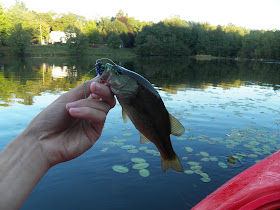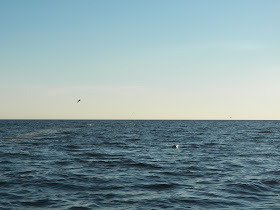There are some fish I will never get tired of catching, and though my days of spinner baits and pitching drop shots are long gone (and permanently gone I might add) I will still take a big bucket mouth any day of the week. And when I lost a big one last night I took it as a personal challenge and went back this morning for revenge. And though many will say that the fly is far from the best way to catch big bass I beg to differ!
I got the yak in the pond early. It was already pretty darn warm at 5:40 this morning so I decided to go with surface bugs exclusively. Though the biggest bass I saw all day took and subsequently shook off a large chartreuse and orange plopper a black and purple plopper, size 2, was really all that was needed and I think the 23 inch fish that got away would probably have stayed attached to that smaller hook.
I started out with the wrong kind of bass:
Then I caught a few of the right kind of bass, but they were not the right size:
Then, as I got to the upper end of the pond, I saw what I was looking for come up behind my fly. I gave the plopper a twitch and the bass ate it with a classic head out of the water gulp. After a spirited battle (smallmouth may fight harder but largemouth are no slouch!) I lipped the first of a good brace of bass.
The next bass was the only one I landed on any color other than black and purple. Hungry! He may not be that big but he wanted a bigger fly than the others.


Pay close attention to this next photo, cause I'm about to drop some bass wisdom on y'all. You should be able to see some structure in the water. In this spot there's a rocky point, I'm guessing it was actually a rock wall made by a mill that was here before the pond was dammed up. It is about 20 feet across, though it widens and deepens as it stretches out into the 3 foot deep flat. on the near side of is is nothing but mud. On the far side is mud and then some rocks, stumps, and lots of pads. I fish that water quickly this time of year because it only has small fish. The top of the point is no deeper than a foot, in fact in most places it is even shallower. If you were to fish it with a subsurface lure or fly you would hang up constantly and get tons of gunk on the hook. It has to be fished with a topwater bug. Now the question many would ask is, why fish the super shallow water, and why aren't there big fish in the pads and the deeper water.
Simple. This time of year the everything that was spawned and hatched out in the spring has reached a few centimeters in length. There are millions of tiny bass, crappie, and sunfish swimming all over the place. These yearling fish need to take a few things into consideration if they are going to survive. They need cover. In open deep water they are easy targets from bellow. In the very shallow water at the margins they are at risk from above and cornered by the shoreline itself. In the shallow lilies which at this time of year are very sparse, they aren't protected well enough. There were two places holding large quantities of juvenile game fish today. Thick lily mats that were isolated in deep open water and that rocky, weedy point. That point provides some cover, is shallow enough that they feel safe from being attacked from below, and there is escape into deep water if the circumstances require it. This point, though it is extremely shallow, is also the only place where a predator fish stands a good chance at filling up on bait fish. Three of the four largest bass I caught today and many of the small ones were in about 8 inches of water on that rocky point. The predators will always be where there is food.

This is what I can catch on a fly in 8 inches of water, this one fought like it was ten pounds!
 |
| Bass thumb achieved |
And after a few dinks and a half hour brake I went back to the point and another great fish trashed the plopper.
Four or five more fish, none very large, and I was ready to head. Hopefully I will be able to get the kayak out to some other ponds because the largemouth bite is only going to be this good for a little while longer.





















































